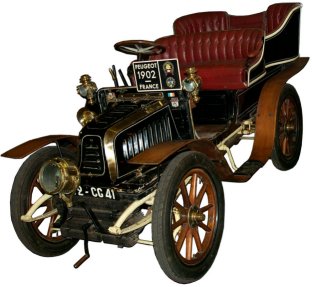
Bookstore
Exercises
Wheel change
Save Energy
History
Formulary

Ganz neu ...

Ganz neu ...
France 1
France 2
France 3
France 4
France 5
Peugeot
History
1891-1918
1918-1945
1945-today
2015 Vision GT
2015 208
2015 Bipper
2014 2008 Castagna
2014 108
2014 308 SW
2014 Boxer
2013 208 GTI
2013 308
2013 2008
2012 208
2012 508 RXH
2011 508
2011 3008 Hybrid 4
2009 RCZ
2007 207 CC
2006 207
2004 407
2004 107
1993 106
1992 905
1987 205 GTI
1986 205 Cabrio
1986 309
1983 205
1979 505
1975 104 Break Prototype
1975 604
1972 104
1969 304
1968 504
1965 204
1965 J7
1962 404 Coupe
1960 404
1955 403
1950 203 C
1948 203
1939 202
1935 402
1934 301 D Coupe
1934 401 Eclipse
1932 183 D Cabrio
1932 301 Torpedo
1931 201
1929 190 S
1929 201 301
1923 Type 172
1923 Type 174
1922 Type 153
1921 Type 156
1920 Quadrilette
1913 Type 146
1913 Bebe
1908 Lion VC
1906 Type 78 A
1905 Quadricycle
1903 Type 56
1891 Vis A Vis
|
 Peugeot 1891 - 1918 Peugeot 1891 - 1918



Peugeot, the brand with the lion, has undergone several changes during its lively history. The history of the family Peugeot reaches back until the 15th century, but this is not our aim here. We take a look at the company from the moment when it converts from a considerable steel producer and further processor to the construction of automobiles. In the description of their products, little steel rods are mentioned for umbrellas and crinolines or corsets and over and over again saw blades. The lion as a brand symbol already appeared in the middle of the 19-th century. It is by origin not the symbol for the automobile construction, but was rather interpreted as a symbol for the steel quality of the company.
Paris plays a significant role in the company history. In France's capital the first world exhibits took place on which not only own products were presented very successfully for the local market, but also for the foreign market. In addition, new ideas and innovations were tested.Gottlieb Daimler's engines garnished all kinds of vehicles at that time. Also two vessels, which navigated on the Seine during the world exhibition of 1889, were equipped with his engines. Through them, Armand Peugeot and Gottlieb Daimler got to know each other. Because Peugeot already produced two-wheeled vehicles and tricycles, it would have been easy to equip them with Daimler engines.
Unfortunately, the influential rest of the Peugeot family had different plans. Thus, Armand Peugeot pursued his own way independently with the corporation 'Societe Anonymous of Automobile Peugeot'. In 1891, the series production of automobiles started. Only 6 years later, the license manufacturing of Daimler engines ceased. Peugeot had its own ideas. The Daimler-V2 became a V-180° which proved itself from the beginning with racing successes or reliability trips. The period till 1914 was highlighted by an active and successful participation in (Grand Prix) racing. For racing, DOHC engines with upright shafts were used, while the standard engines still carried vertical valves.
Especially in France, a lot of automobile competitors rose. Peugeot remained superior by its size of the manufacturing site and the fact that it was able to offer complete cars. At that time, it was common to buy chassis and power drive from one producer and the bodywork from another manufacturer. The Peugeot's were numbered, beginning with 1, reaching No. 35 in 1900. Paris played a leading role as company headquarters again, while the vehicles were manufactured in a modern factory in Audincourt near the east border of France. The two-cylinder engine range was complemented by a one- and a four-cylinder, and not much later even by a six-cylinder engine.
Meanwhile, brother Eugene and his sons had been active, too. The penny-farthing - still standard at the time - was minimized and thus more handily. This was due to the introduction of the bicycle chain which provided for the correct transmission. Peugeot went as far to add cardan shafts (!) to the bicycles. The sales ran brilliantly and created the opportunity for developing an engine drive. It already made use of the four-stroke principle and performed approx. 1 kW. It was connected to the rear wheel at high reduction via an additional chain drive.
Things were progressing so well that the parent firm decided to join in with the automobile production. It started producing automobiles along with the two-wheelers and tricycle production. But this internal competition was ceased when they found themselves with too small shares of the market. To be able to compete, e.g., with Renault, they had to unite (1910). From these days on, Peugeot produces two- and four-wheelers. Shortly after this the main factory was build in Sochaux (Alsace), existing still today. After the death of Armand Peugeot the nephews continued leading the companies, because his own son had died quite early.
Armand Peugeot was far-sighted. He outlined his vehicles also for the goods traffic. Already shortly after the turn of the century, he introduced the bevel standing steering column, the front engine, the cooler and the metal/steel chassis. However, attempts to transfer the production to other business segments, e.g. shipping, failed. But, as so often, the crisis offered new opportunities.
In 1912, a car was introduced, that was fascinating for its lightweight construction and its corresponding low price. Its nickname was Bebe. It was the precursor of the Austin Seven, which later on influenced half of Europe due to its design. The car was designed by Ettore Bugatti, yet with another engine. Some details were also used for his famous (and expensive) cars later on. It was taken over by Peugeot completely. The Bebe was driven by a four-cylinder 850 cm³ engine, performing at this time remarkable 7,5 kW (10 HP), and allowing the vehicle a maximum of 60 km/h. The rigid axles featured leaf springs. The car cost approx. 4,000 francs. This car generated a strong sales success.
During World War I, the automobile industry had to struggle for acceptance in France, because the military leadership did not believe in an advantage by using cars. This changed rapidly, when the German troops achieved war successes by using vehicles for transporting of soldiers and material. Another problem special for Peugeot was that its manufacturing sites were all situated near the eastern border of France, being hard-fought almost during the whole war. A few production lines were placed elsewhere, but the problem of having factories in the center of changing front lines remained till the end of the war.
Surprisingly, automobile companies sometimes profit from war times. In the case of Peugeot new manufacturing methods - assumed from America - were tried out and implemented.
|
|